w
Stereo CODEC with 1W Stereo Class D Speaker Drivers and
Headphone Drivers for Portable Audio Applications
WM8960
DESCRIPTION
The WM8960 is a low power, high quality stereo CODEC
designed for portable digital audio applications.
Stereo class D speaker drivers provide 1W per channel into 8
loads with a 5V supply. Low leakage, excellent PSRR and
pop/click suppression mechanisms also allow direct battery
connection to the speaker supply. Flexible speaker boost
settings allow speaker output power to be maximised while
minimising other analogue supply currents.
A highly flexible input configuration for up to three stereo
sources is integrated, with a complete microphone interface.
External component requirements are drastically reduced as no
separate microphone, speaker or headphone amplifiers are
required. Advanced on-chip digital signal processing performs
automatic level control for the microphone or line input.
Stereo 24-bit sigma-delta ADCs and DACs are used with low
power over-sampling digital interpolation and decimation filters
and a flexible digital audio interface.
The master clock can be input directly or generated internally by
an onboard PLL, supporting most commonly-used clocking
schemes.
The WM8960 operates at analogue supply voltages down to
2.7V, although the digital supplies can operate at voltages down
to 1.71V to save power. The speaker supply can operate at up
to 5.5V, providing 1W per channel into 8 loads. Unused
functions can be disabled using software control to save power.
The WM8960 is supplied in a very small and thin 5x5mm QFN
package, ideal for use in hand-held and portable systems.
FEATURES
DAC SNR 98dB (‘A’ weighted), THD -84dB at 48kHz, 3.3V
ADC SNR 94dB (‘A’ weighted), THD -82dB at 48kHz, 3.3V
Pop and click suppression
Stereo Class D Speaker Driver
3D Enhancement
On-chip Headphone Driver
- <0.1% THD with 1W per channel into 8 BTL speakers
- 70dB PSRR @217Hz
- 87% efficiency (1W output)
- Flexible internal switching clock
- 40mW output power into 16 at 3.3V
- Capless mode support
- THD -75dB at 20mW, SNR 90dB with 16 load
- Pseudo differential for high noise immunity
-
- Programmable ALC / Limiter and Noise Gate
Low Power Consumption
Low Supply Voltages
- Analogue 2.7V to 3.6V (Speaker supply up to 5.5V)
- Digital core and I/O: 1.71V to 3.6V
Integrated low noise MICBIAS
Microphone Interface
5x5x0.9mm QFN package
On-chip PLL provides flexible clocking scheme
Sample rates: 8, 11.025, 12, 16, 22.05, 24, 32, 44.1, 48
APPLICATIONS
Games consoles
Portable media / DVD players
Mobile multimedia
LINPUT3/
JD2
LINPUT2
LINPUT1
RINPUT1
vmid
vmid
RINPUT2
RINPUT3/
JD3
MICBIAS
DGND
DCVDD
DBVDD
Jack Detect
SPKVDD1
SPKVDD2W
SPK_LP
WM8960
CLASS D
0 to -21dB,
3dB steps
0 to -21dB,
3dB steps
DAC
-12 -> 6dB,
3dB steps,
mute
-17.25 to +30dB,
0.75dB steps
INPUT
PGAs
0, 13, 20,
29dB,
mute
0, 13, 20,
29dB,
mute
+
+
+
-
-
+
-17.25 to +30dB,
0.75dB steps
-12 -> 6dB,
3dB steps,
mute
-12 -> 6dB,
3dB steps,
mute
-12 -> 6dB,
3dB steps,
mute
ADC
ADC
DIGITAL
FILTERS
ALC
DAC
DIGITAL
FILTERS
DE-
EMPHASIS
VOLUME
3D ENHANCE
ADC
VOLUME
DAC
LEFT
MIXER
MONO
MIXER
RIGHT
MIXER
Jack Detect
ADCREF,
DACREF
50K
50K
DIGITAL AUDIO
INTERFACE
A-law and u-law support
D
N
G
A
I
D
M
V
D
D
V
A
K
L
C
B
T
A
D
C
D
A
C
R
L
C
A
D
T
A
D
C
A
D
I
/
1
O
P
G
C
R
L
C
D
A
0 to -21dB,
3dB steps
0 to -21dB,
3dB steps
GPIO1
PLL
K
L
C
M
CONTROL
INTERFACE
K
L
C
S
I
N
D
S
-73 to 6dB
1dB steps,
mute
+BOOST
-73 to 6dB
1dB steps,
mute
0dB / -6dB
-73 to 6dB
1dB steps,
mute
CLASS D
-73 to 6dB
1dB steps,
mute
+BOOST
SPK_LN
HP_L
OUT3
HP_R
SPK_RN
SPK_RP
SPKGND1
SPKGND2
WOLFSON MICROELECTRONICS plc
Production Data, August 2013, Rev 4.2
Copyright 2013 Wolfson Microelectronics plc
�
WM8960
Production Data
TABLE OF CONTENTS
DESCRIPTION ....................................................................................................... 1
FEATURES ............................................................................................................ 1
APPLICATIONS ..................................................................................................... 1
TABLE OF CONTENTS ......................................................................................... 2
PIN CONFIGURATION .......................................................................................... 3
ORDERING INFORMATION .................................................................................. 3
PIN DESCRIPTION ................................................................................................ 4
ABSOLUTE MAXIMUM RATINGS ........................................................................ 5
RECOMMENDED OPERATING CONDITIONS ..................................................... 5
ELECTRICAL CHARACTERISTICS ..................................................................... 6
OUTPUT PGA GAIN ............................................................................................ 10
TYPICAL POWER CONSUMPTION .................................................................... 11
SIGNAL TIMING REQUIREMENTS .................................................................... 13
SYSTEM CLOCK TIMING .............................................................................................. 13
AUDIO INTERFACE TIMING – MASTER MODE .......................................................... 13
AUDIO INTERFACE TIMING – SLAVE MODE .............................................................. 14
CONTROL INTERFACE TIMING – 2-WIRE MODE ....................................................... 15
INTERNAL POWER ON RESET CIRCUIT .......................................................... 16
DEVICE DESCRIPTION ...................................................................................... 18
INTRODUCTION ............................................................................................................ 18
INPUT SIGNAL PATH .................................................................................................... 19
ANALOGUE TO DIGITAL CONVERTER (ADC) ............................................................ 26
AUTOMATIC LEVEL CONTROL (ALC) ......................................................................... 28
OUTPUT SIGNAL PATH ................................................................................................ 31
ANALOGUE OUTPUTS ................................................................................................. 37
ENABLING THE OUTPUTS ........................................................................................... 41
HEADPHONE OUTPUT ................................................................................................. 41
CLASS D SPEAKER OUTPUTS .................................................................................... 42
VOLUME UPDATES ...................................................................................................... 43
HEADPHONE JACK DETECT ....................................................................................... 45
THERMAL SHUTDOWN ................................................................................................ 46
GENERAL PURPOSE INPUT/OUTPUT ........................................................................ 47
DIGITAL AUDIO INTERFACE ........................................................................................ 48
AUDIO INTERFACE CONTROL .................................................................................... 52
CLOCKING AND SAMPLE RATES ................................................................................ 56
CONTROL INTERFACE................................................................................................. 63
POWER MANAGEMENT ............................................................................................... 63
REGISTER MAP .................................................................................................. 67
REGISTER BITS BY ADDRESS .................................................................................... 68
DIGITAL FILTER CHARACTERISTICS .............................................................. 82
ADC FILTER RESPONSES ........................................................................................... 83
DAC FILTER RESPONSES ........................................................................................... 83
DE-EMPHASIS FILTER RESPONSES .......................................................................... 85
APPLICATIONS INFORMATION ........................................................................ 86
RECOMMENDED EXTERNAL COMPONENTS ............................................................ 86
IMPORTANT NOTICE ......................................................................................... 90
ADDRESS: ..................................................................................................................... 90
REVISION HISTORY ........................................................................................... 91
w
PD, August 2013, Rev 4.2
2
�
WM8960
Production Data
PIN CONFIGURATION
MICBIAS
LINPUT3/JD2
LINPUT2
LINPUT1
RINPUT1
RINPUT2
RINPUT3/JD3
DCVDD
1
2
3
4
5
6
7
8
32
31
30
29
28
27
26
25
TOP VIEW
9
10
11
12
13
14
15
16
24
23
22
21
20
19
18
17
SPKGND1
SPK_LN
SPK_RP
SPKVDD2
SPKGND2
SPK_RN
SDIN
SCLK
ORDERING INFORMATION
ORDER CODE
TEMPERATURE RANGE
PACKAGE
MOISTURE
SENSITIVITY LEVEL
PEAK SOLDERING
TEMPERATURE
WM8960CGEFL/V
-40C to +85C
32-lead QFN (5x5x0.9mm)
WM8960CGEFL/RV
-40C to +85C
WM8960CGEFL/2RV
-40C to +85C
(Pb-free)
32-lead QFN (5x5x0.9mm)
(Pb-free, Tape and reel)
32-lead QFN (5x5x0.9mm)
(Pb-free, Tape and reel)
Note:
Reel quantity = 3500 (WM8960CGEFL/V and WM8960CGEFL/RV)
Reel quantity = 2200 (WM8960CGEFL/2RV)
MSL3
MSL3
MSL3
260°C
260°C
260°C
w
PD, August 2013, Rev 4.2
3
�
WM8960
PIN DESCRIPTION
Production Data
PIN NO
NAME
MICBIAS
LINPUT3 / JD2
LINPUT2
LINPUT1
RINPUT1
RINPUT2
TYPE
Analogue Output
Analogue Input
Analogue Input
Analogue Input
Analogue Input
Analogue Input
1
2
3
4
5
6
7
8
9
10
11
12
13
14
15
16
17
18
19
20
21
22
23
24
25
26
27
28
29
30
31
32
33
RINPUT3 / JD3
Analogue Input
DCVDD
DGND
DBVDD
MCLK
BCLK
DACLRC
DACDAT
ADCLRC / GPIO1
ADCDAT
SCLK
SDIN
SPK_RN
SPKGND2
SPKVDD2
SPK_RP
SPK_LN
SPKGND1
SPK_LP
SPKVDD1
VMID
AGND
HP_R
OUT3
HP_L
AVDD
GND_PADDLE
Supply
Supply
Supply
Digital Input
Digital Input / Output
Digital Input / Output
Digital Input
Digital Input / Output
Digital Output
Digital Input
Digital Input/Output
Analogue Output
Supply
Supply
Analogue Output
Analogue Output
Supply
Analogue Output
Supply
Analogue Output
Supply
Analogue Output
Analogue Output
Analogue Output
Supply
DESCRIPTION
Microphone bias
Left channel line input /
Left channel positive differential MIC input /
Jack detect input pin
Left channel line input /
Left channel positive differential MIC input
Left channel single-ended MIC input /
Left channel negative differential MIC input
Right channel single-ended MIC input /
Right channel negative differential MIC input
Right channel line input /
Right channel positive differential MIC input
Right channel line input /
Right channel positive differential MIC input /
Jack detect input pin
Digital core supply
Digital ground (Return path for both DCVDD and DBVDD)
Digital buffer (I/O) supply
Master clock
Audio interface bit clock
Audio interface DAC left / right clock
DAC digital audio data
Audio interface ADC left / right clock / GPIO1 pin
ADC digital audio data
Control interface clock input
Control interface data input / 2-wire acknowledge output
Right speaker negative output
Ground for speaker drivers 2
Supply for speaker drivers 2
Right speaker positive output
Left speaker negative output
Ground for speaker drivers 1
Left speaker positive output
Supply for speaker drivers 1
Midrail voltage decoupling capacitor
Analogue ground (Return path for AVDD)
Right output (Line or headphone)
Mono, left, right or buffered midrail output for capless mode
Left output (Line or headphone)
Analogue supply
Die Paddle (Note 1)
Note:
1.
It is recommended that the QFN ground paddle should be connected to analogue ground on the application PCB.
w
PD, August 2013, Rev 4.2
4
�
Production Data
WM8960
ABSOLUTE MAXIMUM RATINGS
Absolute Maximum Ratings are stress ratings only. Permanent damage to the device may be caused by continuously
operating at or beyond these limits. Device functional operating limits and guaranteed performance specifications are given
under Electrical Characteristics at the test conditions specified.
ESD Sensitive Device. This device is manufactured on a CMOS process. It is therefore generically susceptible
to damage from excessive static voltages. Proper ESD precautions must be taken during handling and storage
of this device.
Wolfson tests its package types according to IPC/JEDEC J-STD-020 for Moisture Sensitivity to determine acceptable storage
conditions prior to surface mount assembly. These levels are:
MSL1 = unlimited floor life at <30C / 85% Relative Humidity. Not normally stored in moisture barrier bag.
MSL2 = out of bag storage for 1 year at <30C / 60% Relative Humidity. Supplied in moisture barrier bag.
MSL3 = out of bag storage for 168 hours at <30C / 60% Relative Humidity. Supplied in moisture barrier bag.
The Moisture Sensitivity Level for each package type is specified in Ordering Information.
MIN
-0.3V
-0.3V
MAX
+4.5V
+7V
DBVDD +0.3V
AVDD +0.3V
CONDITION
Supply voltages (excluding SPKVDD1 and SPKVDD2)
SPKVDD1, SPKVDD2
Voltage range digital inputs
Voltage range analogue inputs
Operating temperature range, TA
Storage temperature after soldering
Notes:
1. Analogue, digital and speaker grounds must always be within 0.3V of each other.
2. All digital and analogue supplies are completely independent from each other (i.e. not internally connected).
3. DCVDD must be less than or equal to AVDD and DBVDD.
4. AVDD must be less than or equal to SPKVDD1 and SPKVDD2.
5. SPKVDD1 and SPKVDD2 must be high enough to support the peak output voltage when using DCGAIN and ACGAIN
DGND -0.3V
AGND -0.3V
+85C
+150C
-40C
-65C
functions, to avoid output waveform clipping. Peak output voltage is AVDD*(DCGAIN+ACGAIN)/2.
RECOMMENDED OPERATING CONDITIONS
PARAMETER
Digital supply range (Core)
Digital supply range (Buffer)
Analogue supplies range
Speaker supply range
Ground
SYMBOL
DCVDD
DBVDD
AVDD
DGND, AGND, SPKGND1,
SPKVDD1, SPKVDD2
SPKGND2
MIN
1.71
1.71
2.7
2.7
TYP
0
MAX
3.6
3.6
3.6
5.5
UNIT
V
V
V
V
V
w
PD, August 2013, Rev 4.2
5
�
WM8960
Production Data
ELECTRICAL CHARACTERISTICS
Test Conditions
DCVDD = 1.8V, DBVDD = 3.3V, AVDD = SPKVDD1 = SPKVDD2 = 3.3V, TA = +25oC, 1kHz signal, fs = 48kHz, PGA gain = 0dB,
24-bit audio data unless otherwise stated.
TYP
MAX
UNIT
SYMBOL
PARAMETER
MIN
Analogue Inputs (LINPUT1, RINPUT1, LINPUT2, LINPUT3, RINPUT2, RINPUT3)
Full-scale Input Signal Level –
note this changes in proportion
to AVDD
TEST CONDITIONS
VINFS
L/RINPUT1,2,3
Single-ended
L/RINPUT1,2,3
Differential MIC
Mic PGA equivalent input noise
0 to 20kHz,
+30dB gain
Input resistance
(Note that input boost and
bypass path resistances will be
seen in parallel with PGA input
resistance when these paths are
enabled)
L/RINPUT1
+30dB PGA gain
Differential or single-
ended MIC configuration
L/RINPUT1
0dB PGA gain
L/RINPUT1
L/RINPUT2,
L/RINPUT3
L/RINPUT2,
L/RINPUT3
L/RINPUT2,
L/RINPUT3
L/RINPUT2,
L/RINPUT3
L/RINPUT3
Differential or single-
ended MIC configuration
-17.25dB PGA gain
Differential or single-
ended MIC configuration
(Constant for all gains)
Differential MIC
configuration
Max boost gain
L/RINPUT2/3 to boost
0dB boost gain
L/RINPUT2/3 to boost
Min boost gain
L/RINPUT2/3 to boost
Max bypass gain
L/RINPUT3 to bypass
L/RINPUT3
Min bypass gain
L/RINPUT3 to bypass
Input capacitance
MIC Programmable Gain Amplifier (PGA)
Programmable Gain Min
Programmable Gain Max
Programmable Gain Step Size
Mute Attenuation
Selectable Input Gain Boost
Gain Boost Steps
Guaranteed monotonic
LMIC2B = 0 and
RMIC2B = 0
Input from PGA
Input from L/RINPUT2 or
L/RINPUT3
1.0
0
0.5
-6
150
3
49
87
85
7.5
13
37
17
70
10
-17.25
30
0.75
85
0, 13, 20,
29, MUTE
-12, -9, -6,
-3, 0, 3, 6,
MUTE
94
93
-86
0.005
-80
0.01
Vrms
dBV
Vrms
dBV
uV
k
k
k
k
k
k
k
k
k
pF
dB
dB
dB
dB
dB
dB
dB
dB
%
Analogue Inputs (LINPUT1/2 Differential, RINPUT1/2 Differential) to ADC out via MIC PGA
Signal to Noise Ratio
(A-weighted)
Total Harmonic Distortion Plus
Noise
THD+N
SNR
AVDD = 3.3V
AVDD = 2.7V
-3dBFs input,
AVDD = 3.3V
-3dBFs input,
AVDD = 2.7V
w
PD, August 2013, Rev 4.2
6
�
Production Data
WM8960
Test Conditions
DCVDD = 1.8V, DBVDD = 3.3V, AVDD = SPKVDD1 = SPKVDD2 = 3.3V, TA = +25oC, 1kHz signal, fs = 48kHz, PGA gain = 0dB,
24-bit audio data unless otherwise stated.
SYMBOL
TEST CONDITIONS
MIN
PARAMETER
Total Harmonic Distortion
THD
Analogue Inputs (LINPUT2, RINPUT2) to ADC out
Signal to Noise Ratio
(A-weighted)
Total Harmonic Distortion Plus
Noise
THD+N
SNR
Total Harmonic Distortion
THD
Analogue Inputs (LINPUT3, RINPUT3) to ADC out
Signal to Noise Ratio
(A-weighted)
Total Harmonic Distortion Plus
Noise
THD+N
SNR
Total Harmonic Distortion
THD
Analogue Inputs (LINPUT1, RINPUT1, LINPUT2, RINPUT2, LINPUT3, RINPUT3) to ADC out
ADC Channel Separation
95
1kHz full scale signal into
ADC via L/RINPUT1, MIC
amp (single-ended) and
boost
1kHz full scale signal into
ADC via L/RINPUT1/2,
MIC amp (pseudo-
differential) and boost
1kHz full scale signal into
ADC via L/RINPUT2 and
boost
1kHz full scale signal into
ADC via L/RINPUT3 and
boost
Single-ended MIC input
on L/RINPUT1
Differential MIC input
using L/RINPUT2
1kHz on LINPUT2 to ADC
via boost only
1kHz on LINPUT1 to ADC
via single-ended MIC
PGA & boost
1kHz signal
Line Input / MIC Separation
(Quiescent input to ADC via
boost; Output on ADC;
1kHz on L/RINPUT3 to HP out
via bypass path)
Boost / Bypass Separation
(Quiescent L/RINPUT3 to HP
outputs via bypass)
Channel Matching
w
85
85
92
98
90
96
116
0.2
-3dBFs input,
AVDD = 3.3V
-3dBFs input,
AVDD = 2.7V
AVDD = 3.3V
AVDD = 2.7V
-3dBFs input,
AVDD = 3.3V
-3dBFs input,
AVDD = 2.7V
-3dBFs input,
AVDD = 3.3V
-3dBFs input,
AVDD = 2.7V
AVDD = 3.3V
AVDD = 2.7V
-3dBFs input,
AVDD = 3.3V
-3dBFs input,
AVDD = 2.7V
-3dBFs input,
AVDD = 3.3V
-3dBFs input,
AVDD = 2.7V
84
TYP
-89
0.004
-81
0.009
94
93
-86
0.005
-80
0.01
-89
0.004
-81
0.009
94
93
-86
0.005
-80
0.01
-89
0.004
-81
0.009
MAX
-80
-80
UNIT
dB
%
dB
dB
%
dB
%
dB
dB
%
dB
%
dB
dB
dB
dB
dB
dB
dB
dB
dB
PD, August 2013, Rev 4.2
7
�
WM8960
Production Data
Test Conditions
DCVDD = 1.8V, DBVDD = 3.3V, AVDD = SPKVDD1 = SPKVDD2 = 3.3V, TA = +25oC, 1kHz signal, fs = 48kHz, PGA gain = 0dB,
24-bit audio data unless otherwise stated.
TEST CONDITIONS
MIN
TYP
MAX
UNIT
SYMBOL
PARAMETER
Headphone Outputs (HP_L, HP_R)
0dB Full scale output voltage
Mute attenuation
Channel Separation
1kHz, full scale signal
L/RINPUT3 to headphone
outputs via bypass
DAC to Line-Out (HP_L or HP_R with 10k / 50pF load)
Signal to Noise Ratio
(A-weighted)
Total Harmonic Distortion Plus
Noise
Total Harmonic Distortion
THD+N
SNR
THD
AVDD=3.3V
AVDD=2.7V
AVDD=3.3V
AVDD=2.7V
AVDD=3.3V
AVDD=2.7V
Channel Separation
DAC to Line-Out (OUT3 with 10k / 50pF load)
Signal to Noise Ratio
(A-weighted)
Total Harmonic Distortion Plus
Noise
Total Harmonic Distortion
THD+N
SNR
THD
1kHz full scale signal
AVDD=3.3V
AVDD=2.7V
AVDD=3.3V
AVDD=2.7V
AVDD=3.3V
AVDD=2.7V
AVDD/3.3
86
110
99
98
-85
-90
-87
-92
110
99
98
-85
-90
-87
-92
110
-80
-80
90
-78
0.013
-75
0.018
-72
0.025
-70
0.032
99
98
-78
0.013
-72
0.025
-75
0.018
-70
0.032
Vrms
dB
dB
dB
dB
dB
dB
dB
dB
dB
dB
dB
%
dB
dB
%
dB
%
dB
%
dB
%
Channel Separation
Headphone Output (HP_L, HP_R, using capacitors unless otherwise specified)
Output Power per channel
Total Harmonic Distortion Plus
Noise
AVDD=2.7V, RL=32
1kHz full scale signal
THD+N
PO
PO=5mW
Output power is very closely correlated with THD; see below.
SNR
Signal to Noise Ratio
(A-weighted)
Speaker Outputs (DAC to SPK_LP, SPK_LN, SPK_RP, SPK_RN with 8 bridge tied load)
Output Power
Total Harmonic Distortion Plus
Noise
(DAC to speaker outputs)
THD+N
92
PO
Output power is very closely correlated with THD; see below
AVDD=2.7V, RL=16
PO=5mW
AVDD=3.3V, RL=32,
PO=20mW
AVDD=3.3V, RL=16,
PO=20mW
AVDD = 3.3V
AVDD = 2.7V
PO =200mW, RL = 8,
SPKVDD1=SPKVDD2
=3.3V; AVDD=3.3V
PO =320mW, RL = 8,
SPKVDD1=SPKVDD2
=3.3V; AVDD=3.3V
PO =500mW, RL = 8,
SPKVDD1=SPKVDD2
=5V; AVDD=3.3V
PO =1W, RL = 8,
SPKVDD1=SPKVDD2
=5V; AVDD=3.3V
w
PD, August 2013, Rev 4.2
8
�
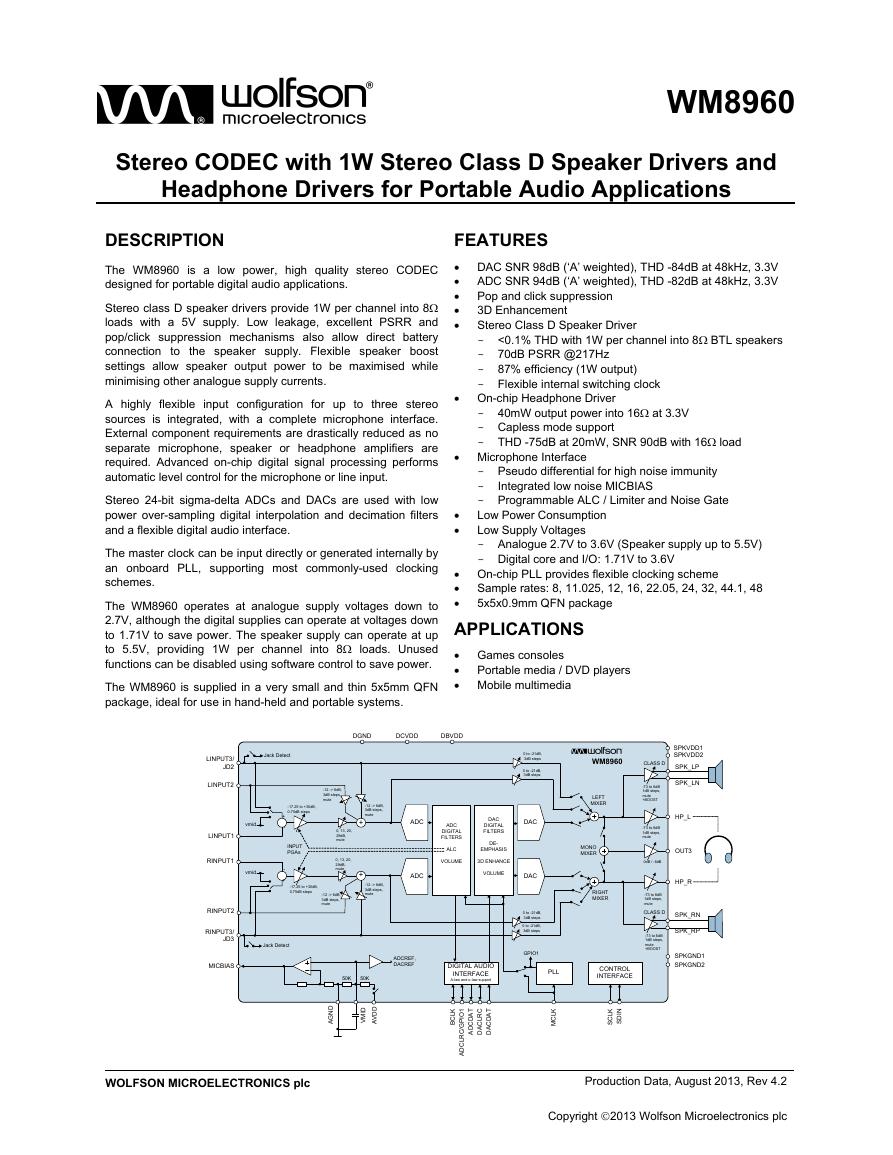

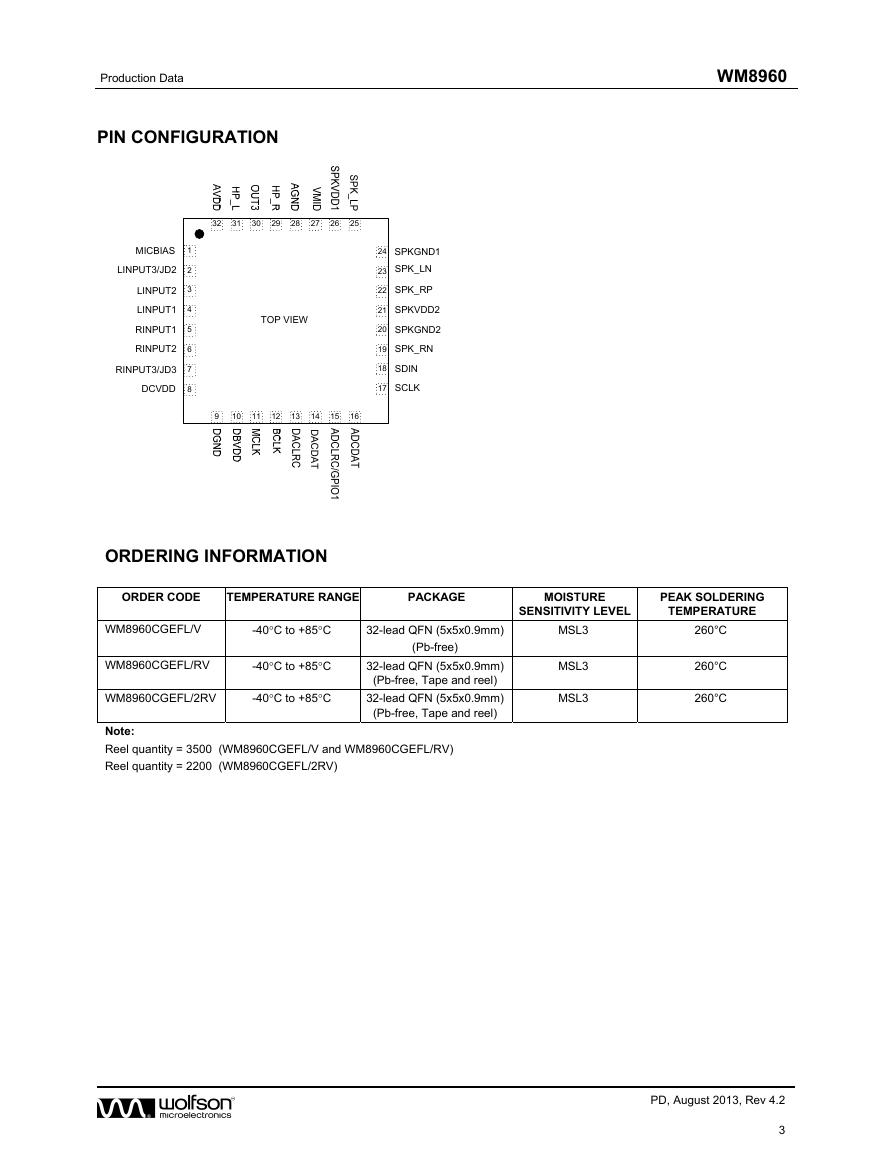
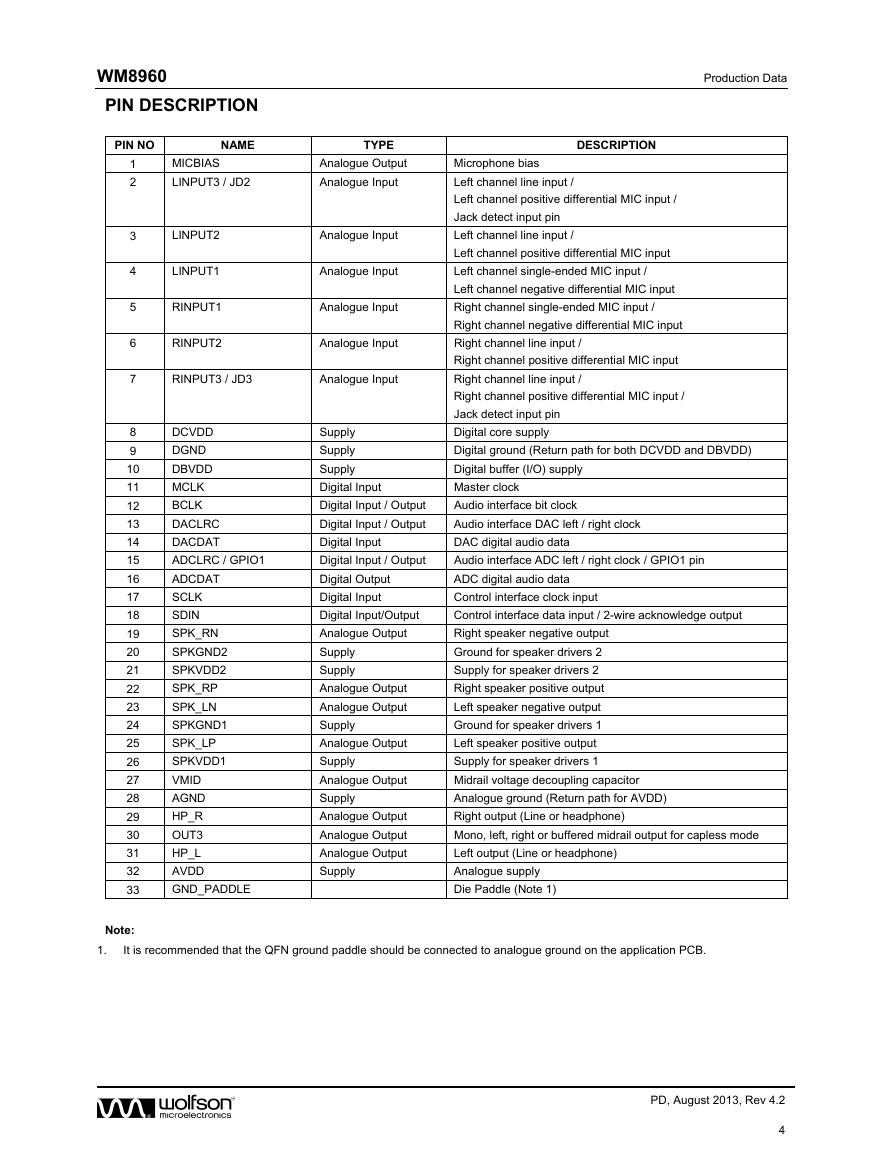
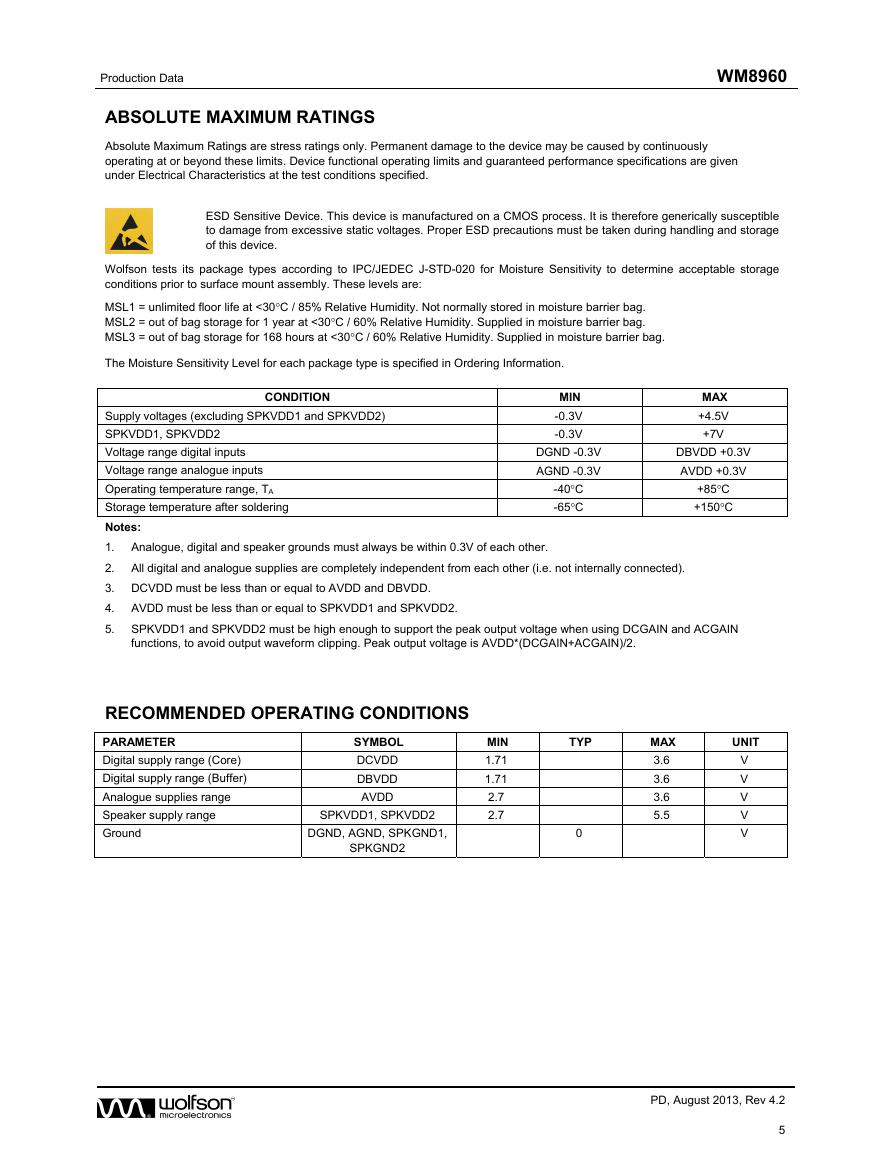
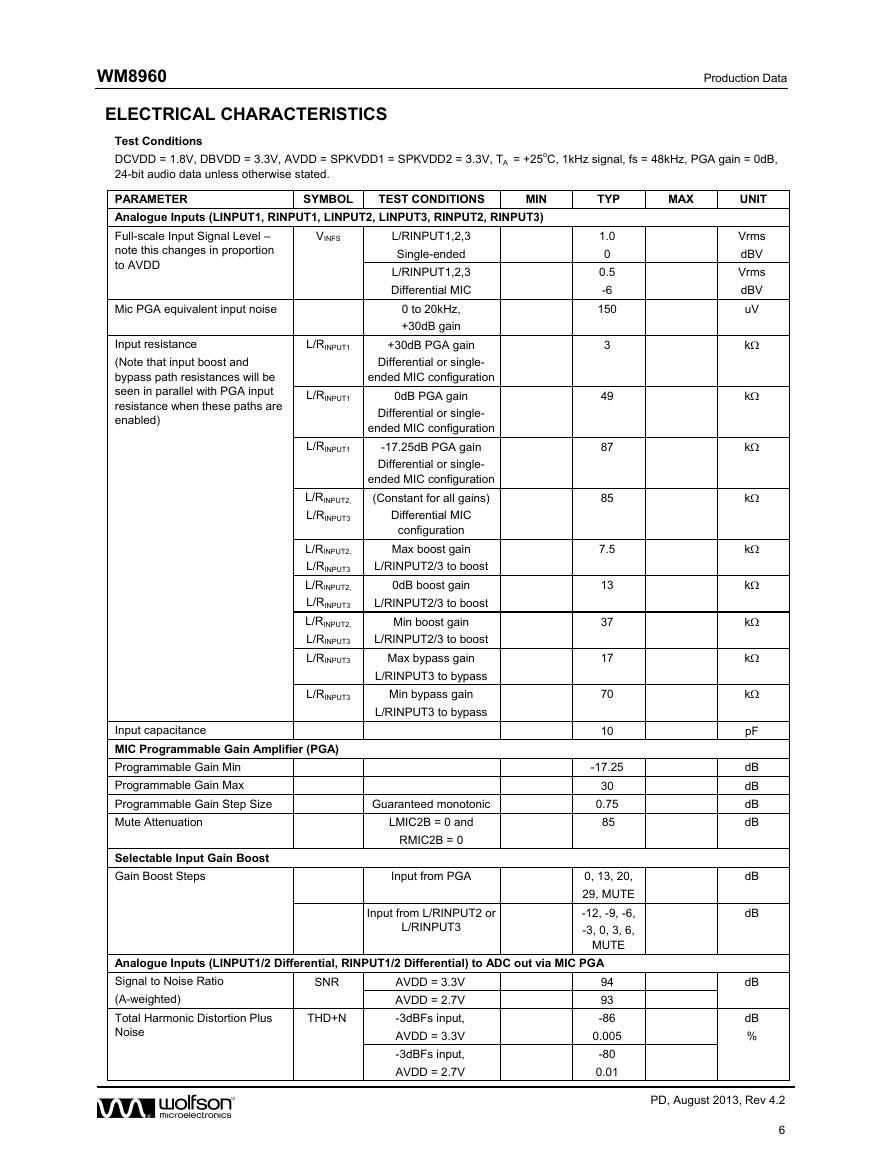
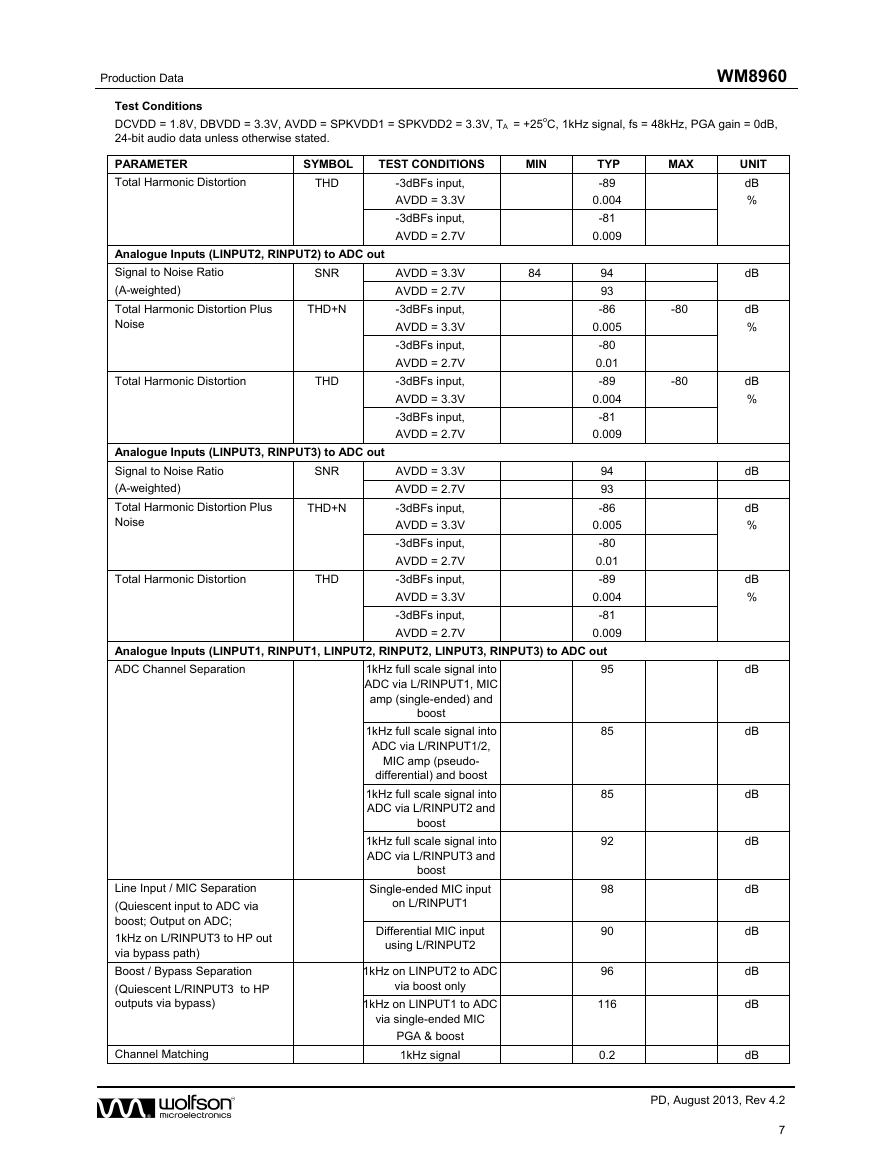
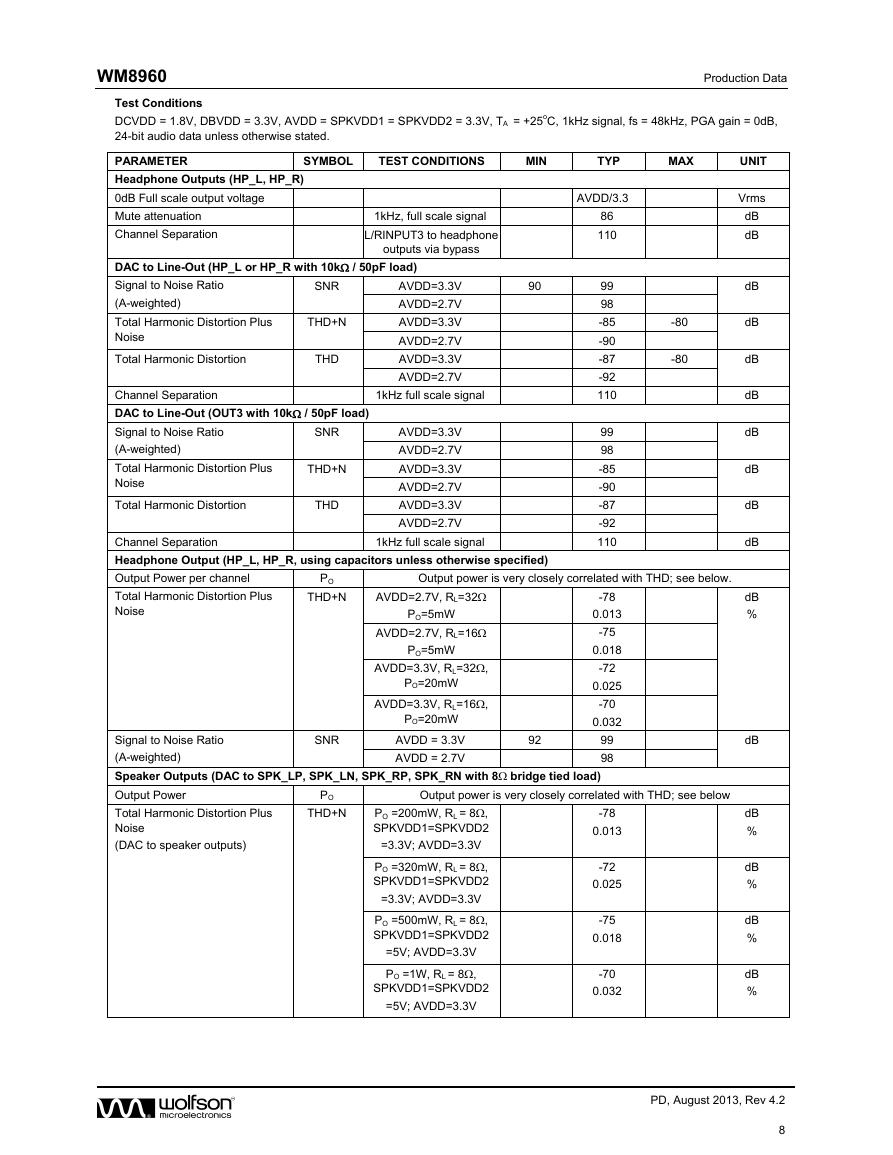








 V2版本原理图(Capacitive-Fingerprint-Reader-Schematic_V2).pdf
V2版本原理图(Capacitive-Fingerprint-Reader-Schematic_V2).pdf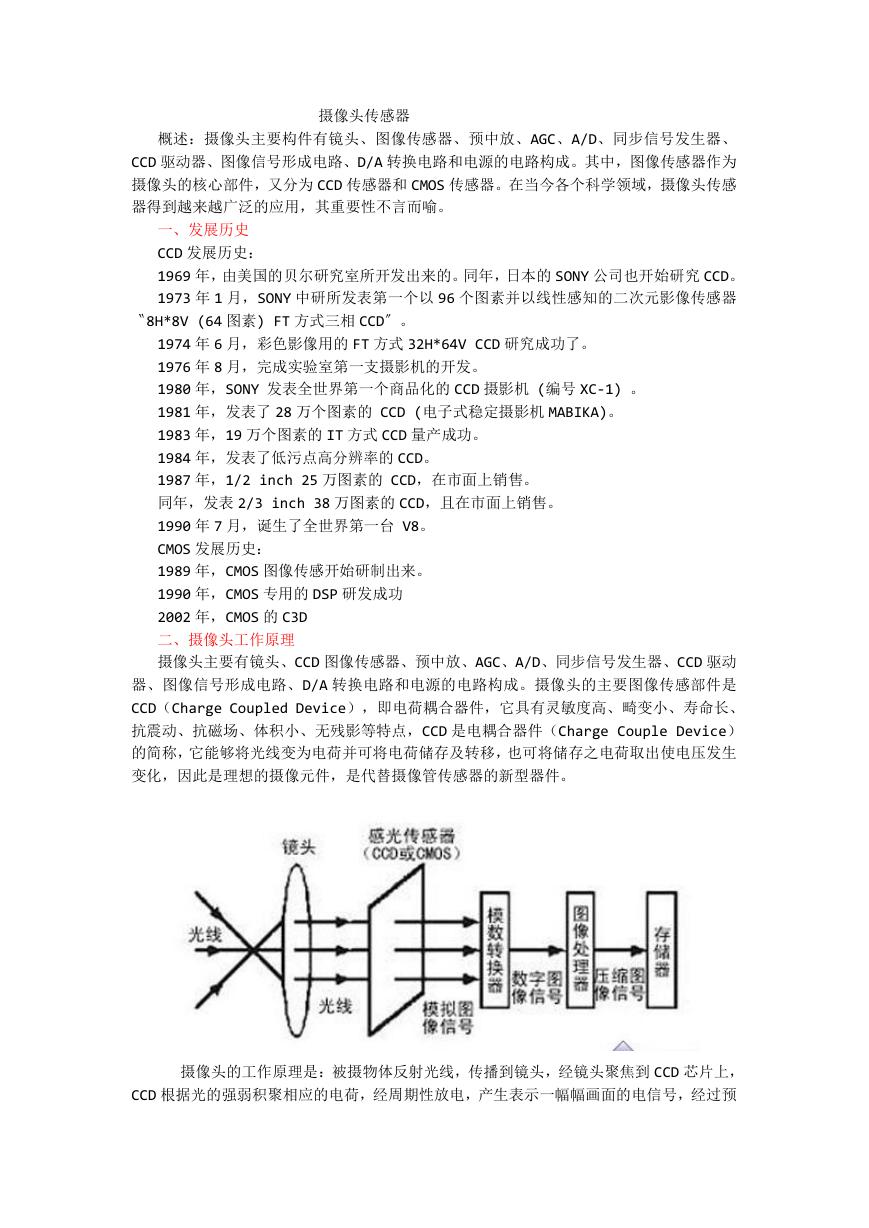 摄像头工作原理.doc
摄像头工作原理.doc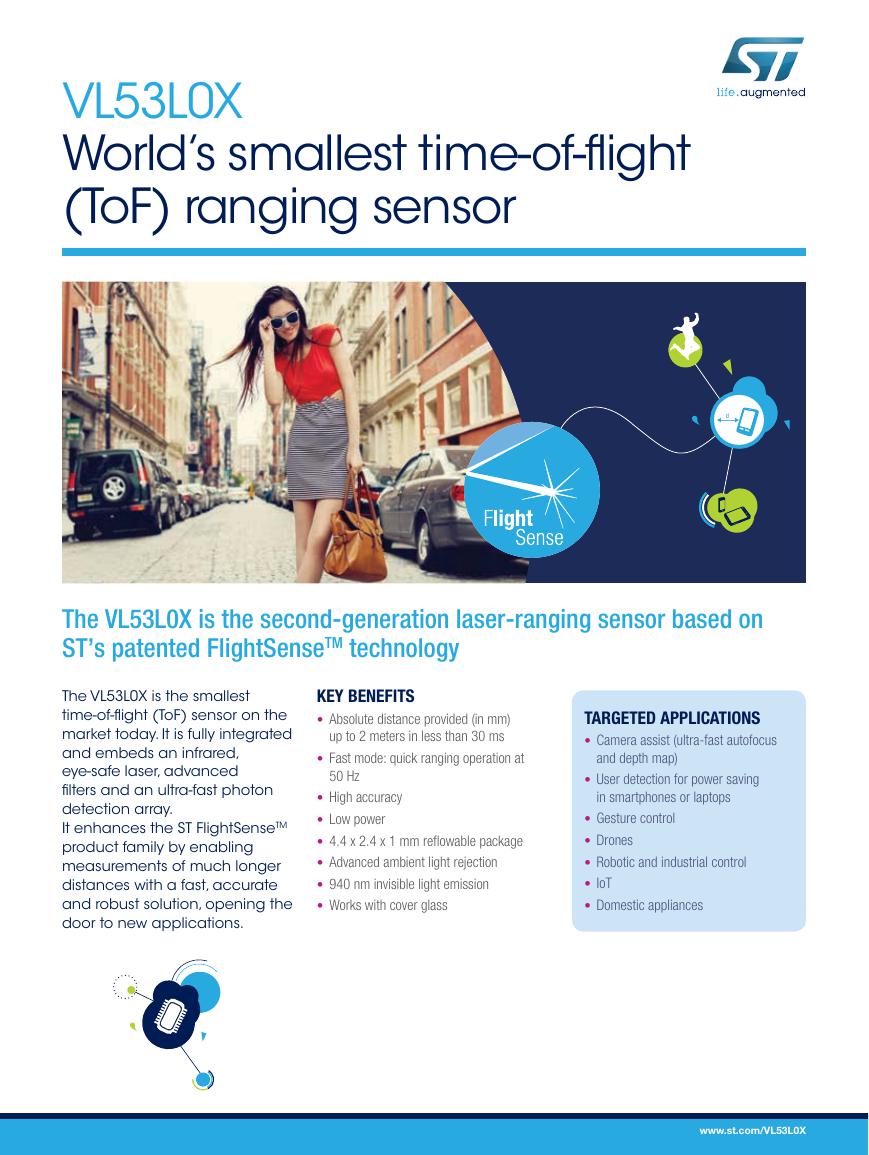 VL53L0X简要说明(En.FLVL53L00216).pdf
VL53L0X简要说明(En.FLVL53L00216).pdf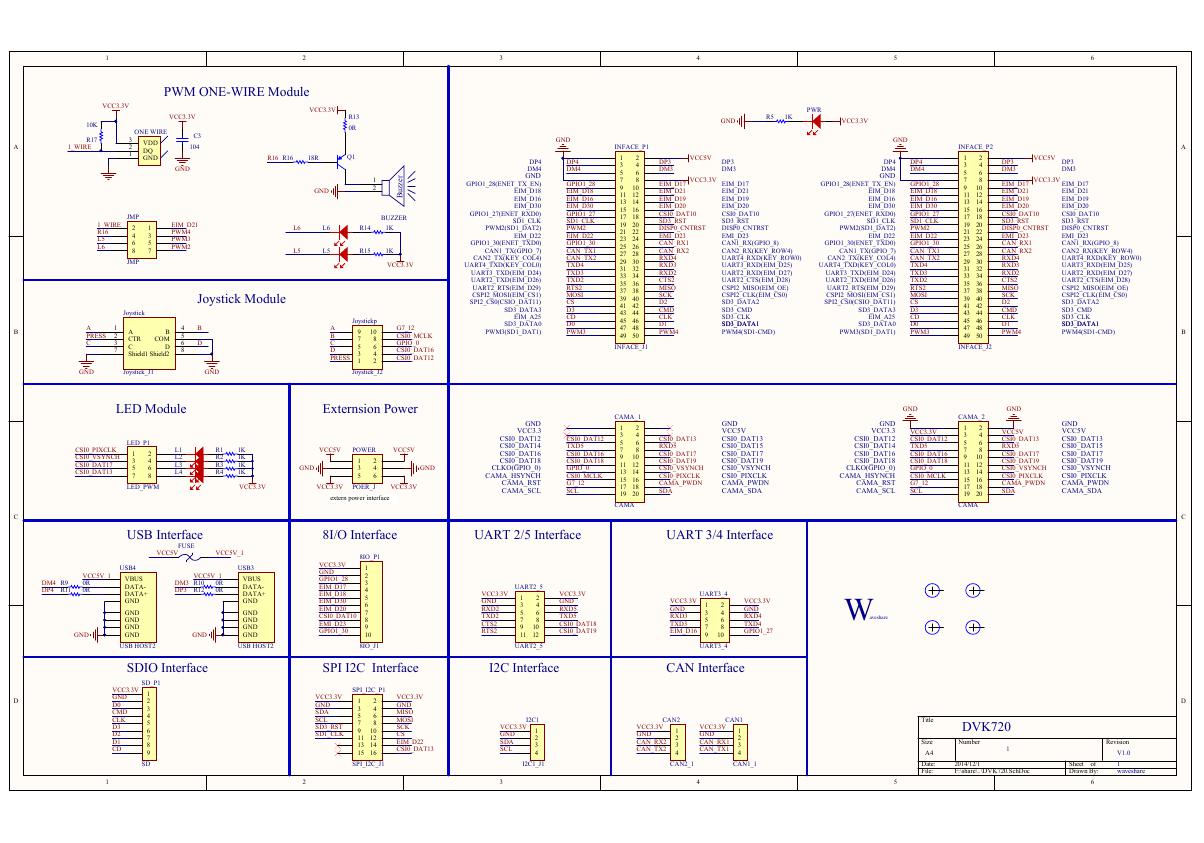 原理图(DVK720-Schematic).pdf
原理图(DVK720-Schematic).pdf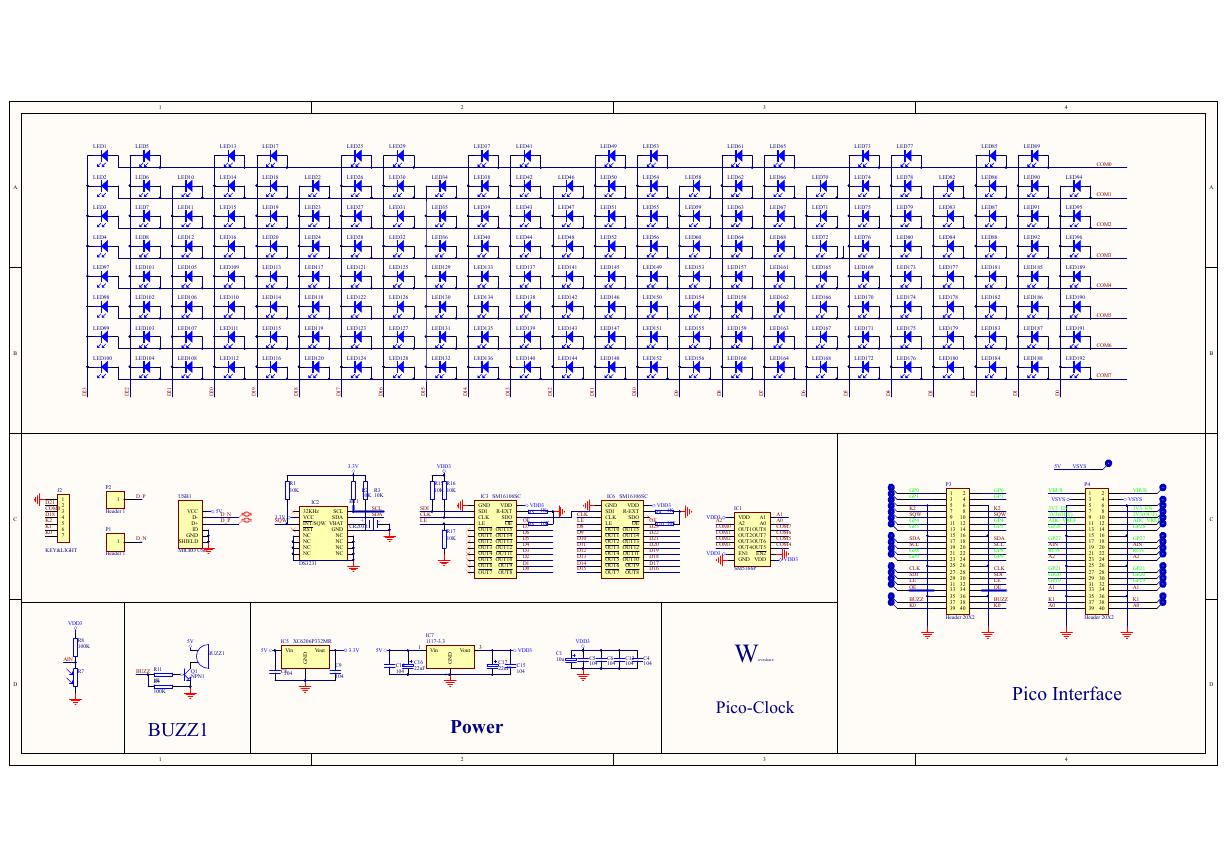 原理图(Pico-Clock-Green-Schdoc).pdf
原理图(Pico-Clock-Green-Schdoc).pdf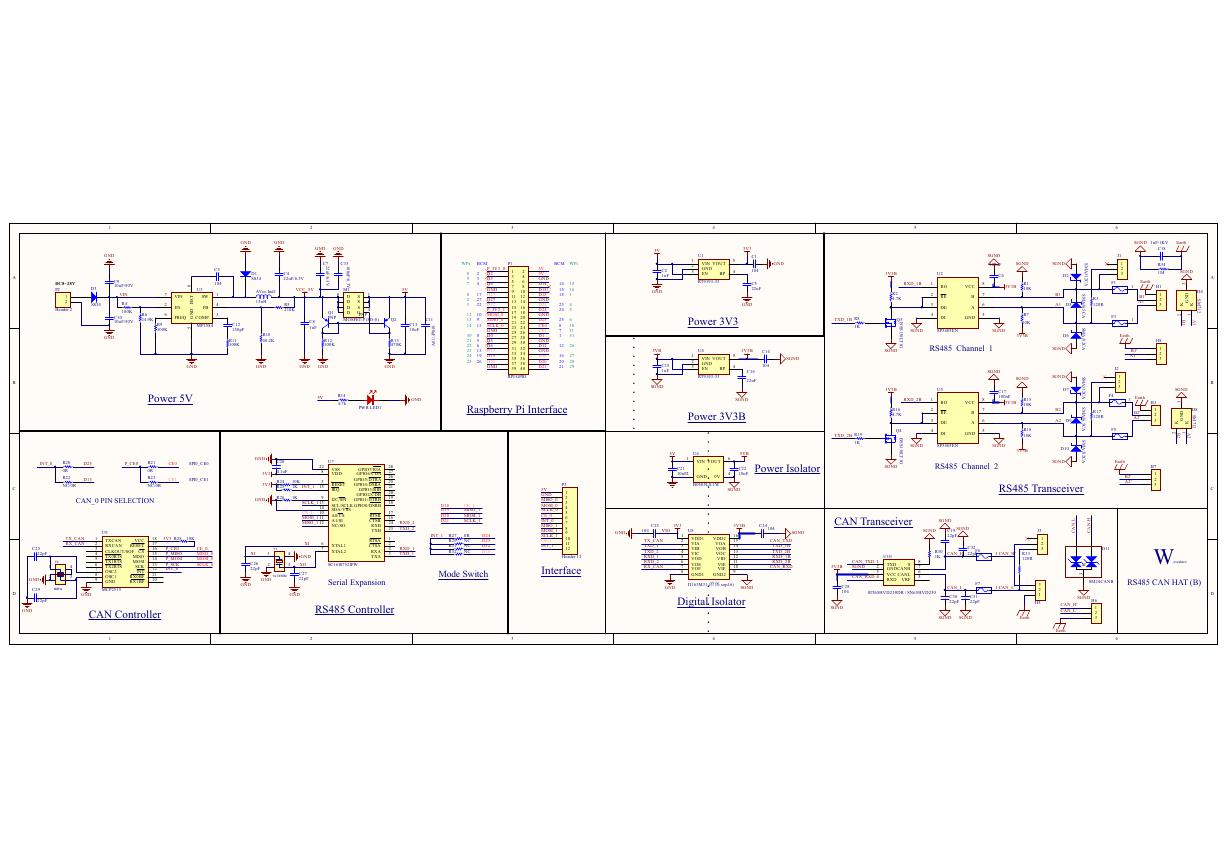 原理图(RS485-CAN-HAT-B-schematic).pdf
原理图(RS485-CAN-HAT-B-schematic).pdf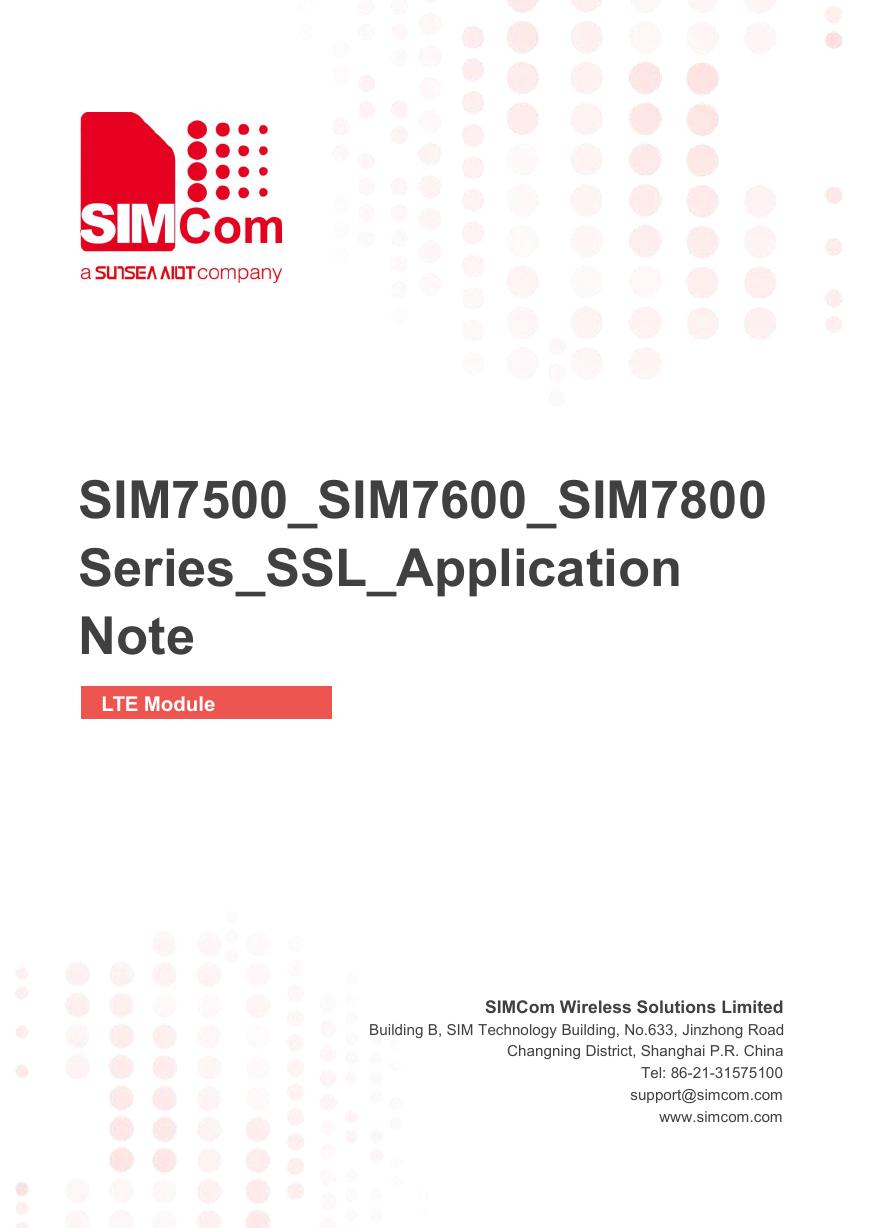 File:SIM7500_SIM7600_SIM7800 Series_SSL_Application Note_V2.00.pdf
File:SIM7500_SIM7600_SIM7800 Series_SSL_Application Note_V2.00.pdf ADS1263(Ads1262).pdf
ADS1263(Ads1262).pdf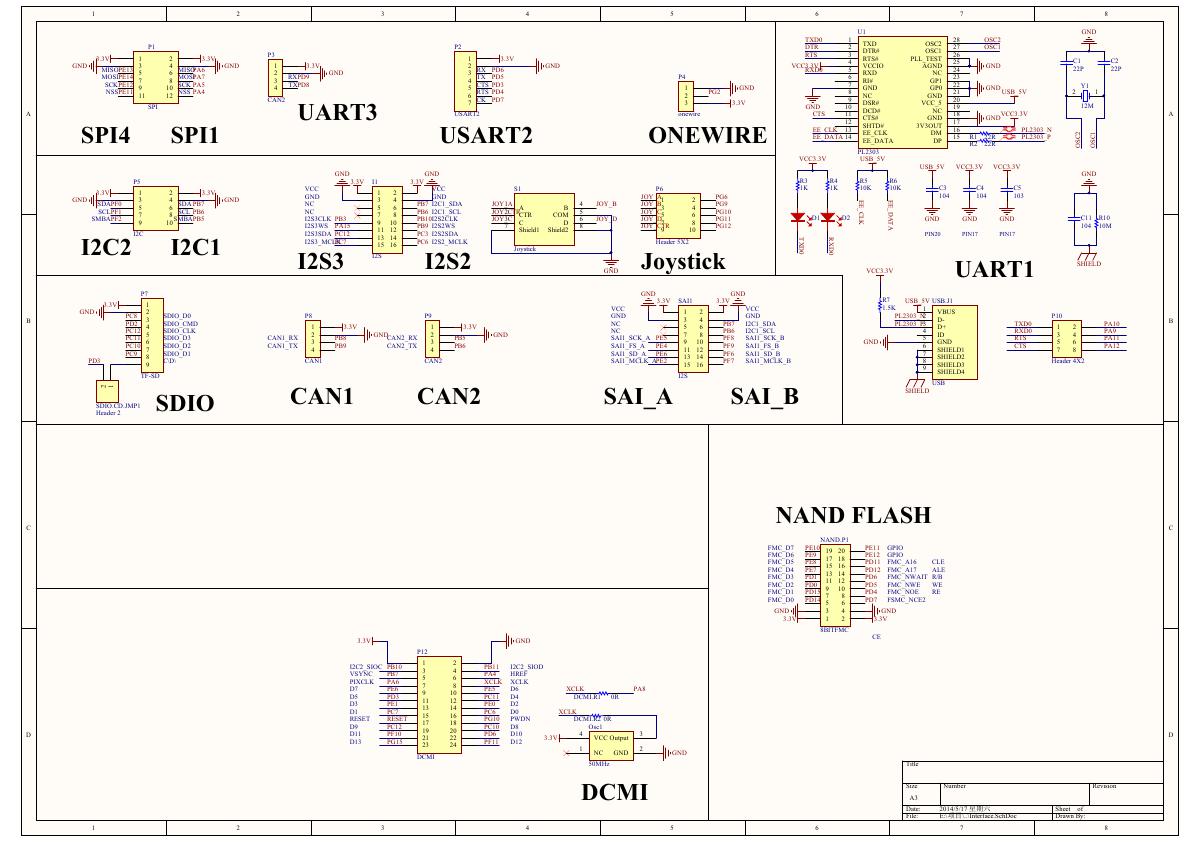 原理图(Open429Z-D-Schematic).pdf
原理图(Open429Z-D-Schematic).pdf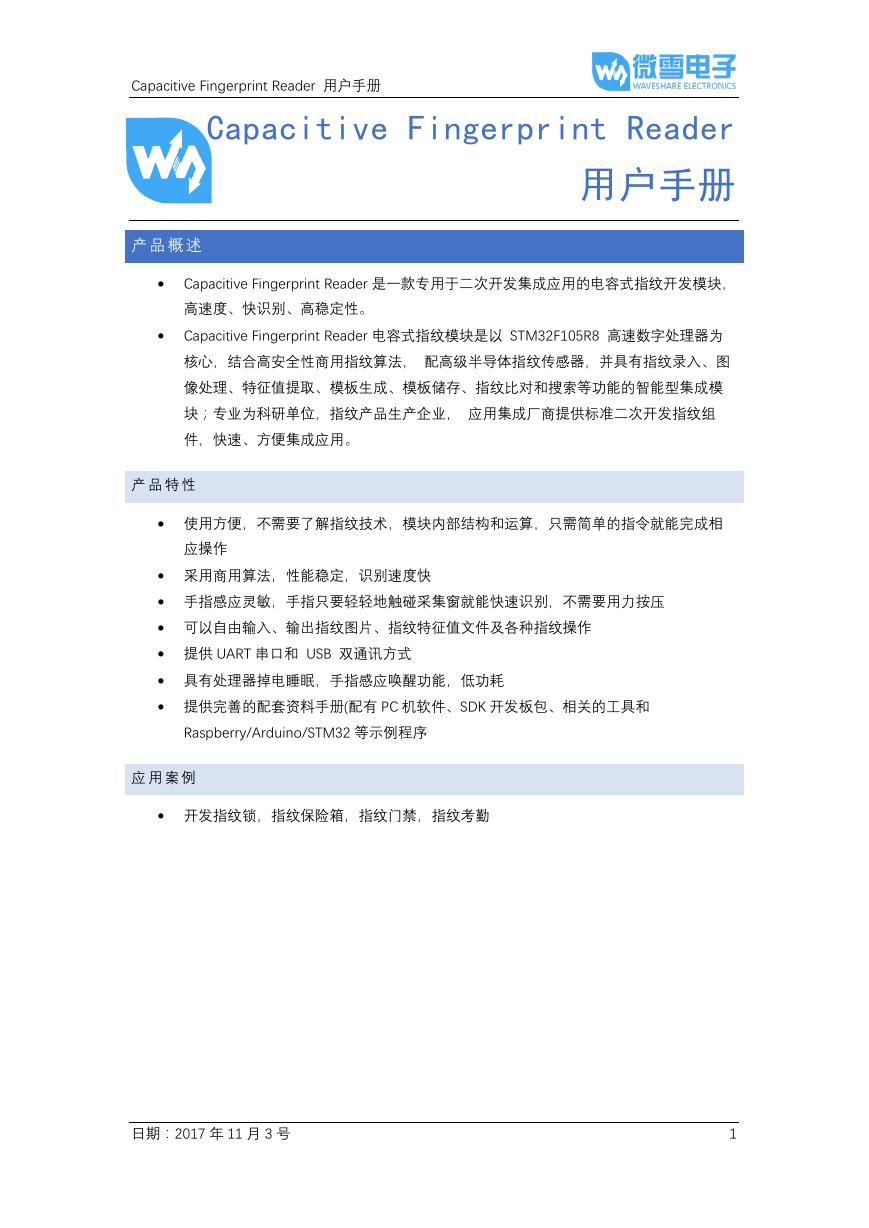 用户手册(Capacitive_Fingerprint_Reader_User_Manual_CN).pdf
用户手册(Capacitive_Fingerprint_Reader_User_Manual_CN).pdf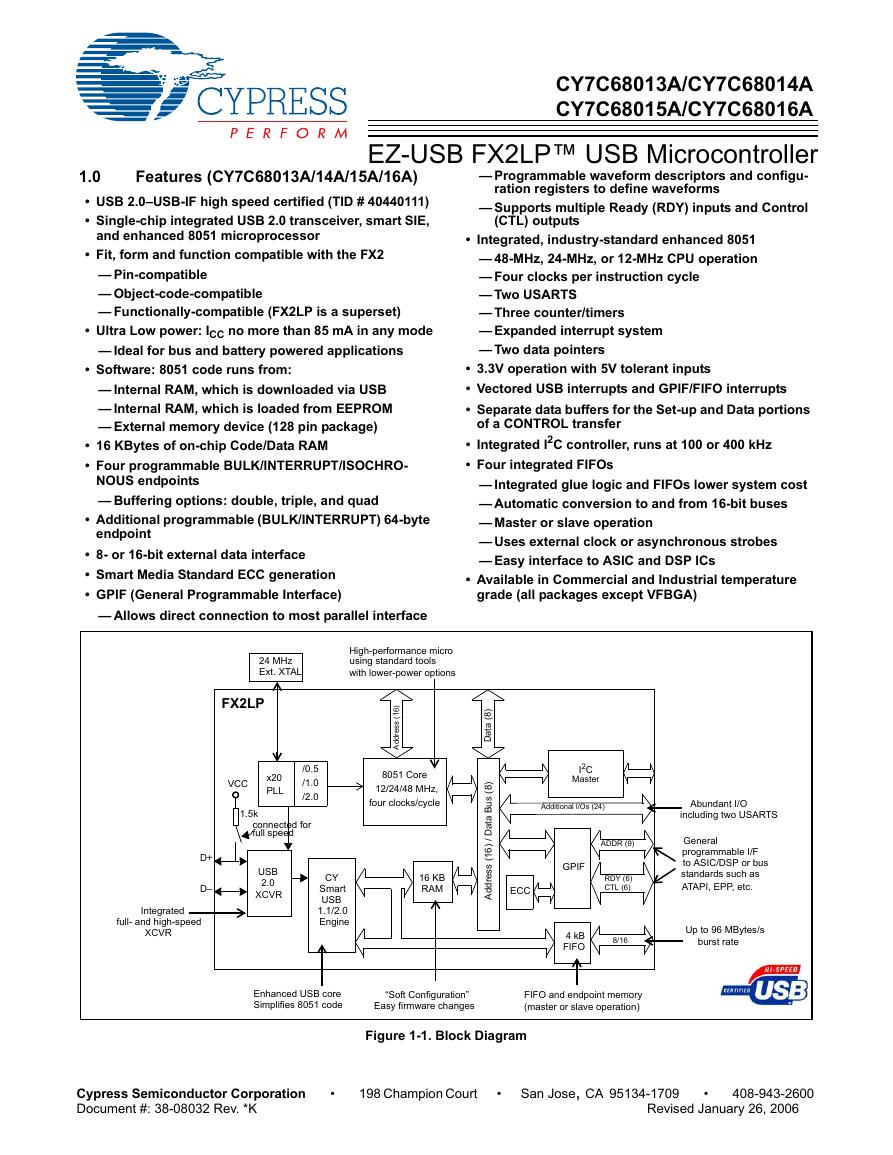 CY7C68013A(英文版)(CY7C68013A).pdf
CY7C68013A(英文版)(CY7C68013A).pdf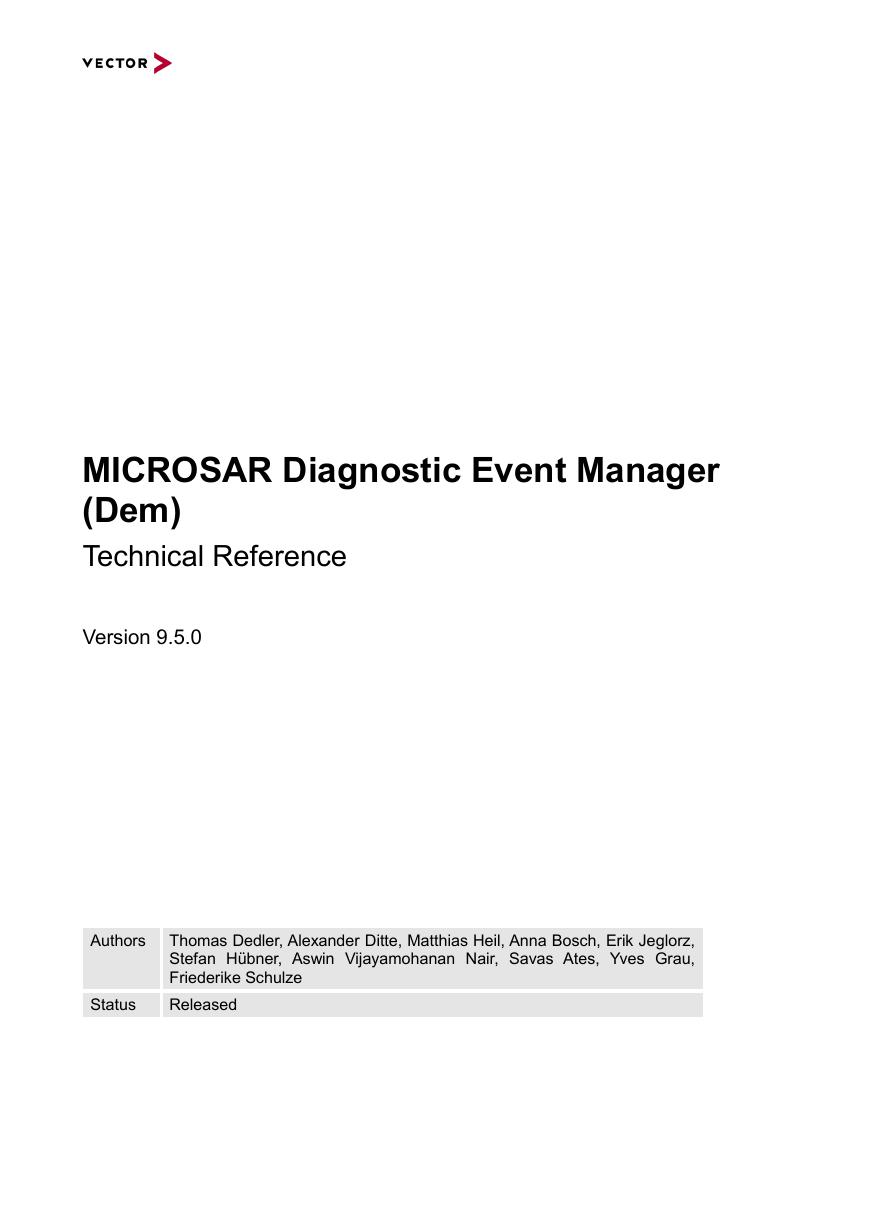 TechnicalReference_Dem.pdf
TechnicalReference_Dem.pdf